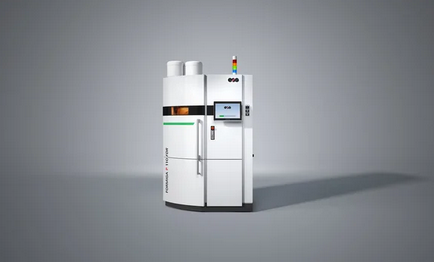 EOS, a leading supplier for responsible manufacturing solutions via industrial 3D printing technology, is looking at sustainability from a holistic perspective. EOS is continuously striving for more sustainable materials, systems, and processes. At formnext 2022 (November 15 to 18, Frankfurt, Germany), EOS will introduce a climate neutral PA 1101 and carbon-reduced PA 2200 polymer material. At the show, EOS will also present Fine Detail Resolution (FDR) for the FORMIGA P 110 polymer system.
EOS, a leading supplier for responsible manufacturing solutions via industrial 3D printing technology, is looking at sustainability from a holistic perspective. EOS is continuously striving for more sustainable materials, systems, and processes. At formnext 2022 (November 15 to 18, Frankfurt, Germany), EOS will introduce a climate neutral PA 1101 and carbon-reduced PA 2200 polymer material. At the show, EOS will also present Fine Detail Resolution (FDR) for the FORMIGA P 110 polymer system.
When it comes to responsible manufacturing, we currently evaluate the climate impact of every aspect of industrial 3D printing to create transparency of the status quo.
We also evaluate and improve production efficiency. For our new environmentally green materials, we reduce greenhouse gas emissions as much as possible. And we invest in Gold Standard climate protection projects to offset the unavoidable greenhouse gas emissions.
Sustainability is not just a key driver for us but has also become increasingly important to our customers as well, e.g., in the consumer goods industry.
Björn Hannappel, Head of Sustainability bei EOS
By far most customers trust in the excellent properties of our PA 1101 and PA 2200 materials.
We are proud to offer them a carbon-reduced and even -neutral version.
This enables us to support their sustainability goals while maintaining the proven part quality they have built their businesses on.
Moritz Kügler, VP BU Polymer Materials at EOS
When it comes to 3D printing materials, EOS looks at three dimensions: material sourcing, material consumption during the 3D printing process, and material reusability for continuous part production the reduction of powder waste,
For material sourcing, EOS particularly focuses on three factors: the choice of polymers for 3D printing, how the polymer powders are being generated, and how the qualified additive manufacturing powder is being processed on EOS systems. Depending on the choice of raw materials, the CO2e footprint for additive manufacturing powder production can be reduced by increased production efficiency and quality to lower scrap and increase material reusability throughout the production journey.
PA 1101 ClimateNeutral polymer material
PA 1101 is a bio-based material and with a smaller carbon footprint than petrol-based polymers. Production efficiency has been and will be continuously improved for this material too. EOS now offers a PA 1101 ClimateNeutral material.
The term climate-neutral reflects the broader inclusiveness of other greenhouse gases in climate change, even if carbon dioxide is the most abundant. The material comes with proven quality and material composition, yet now it is climate neutral to support customer’s own climate protection and sustainability goals.
Customers will receive a certificate that proves the correct calculation and offsetting for the application.
Polymer Werkstoff: PA 2200 CarbonReduced
PA 2200 CarbonReduced polymer material
PA 2200 has a notable set of properties for final part properties. The material is traditionally a petrol-based polymer, with an elevated impact on climate.
EOS aims to constantly increase production efficiency of this material while providing the added value of almost 45 percent reduced CO2e footprint of the PA 2200 CarbonReduced.
For material production, renewable energies are used.
FORMIGA P 110 FDR: for filigree and stable parts, smooth surfaces, ultra-thin walls
Where delicate structures with fine surfaces and thin walls are key to application builds, fine detail resolution (FDR) is the right solution. EOS developed the FDR technology for their polymer systems to increase customer’s ability to print with fine detail in mind. At formnext, EOS introduces the FORMIGA P 110 FDR polymer system.
Unlike other options in the EOS system portfolio, it uses a CO laser with a focus diameter twice as small as existing SLS technologies. With this, extremely fine surfaces can be achieved, as well as delicate but stable parts with a minimum wall thickness of just 0.22 mm. The material is being processes in layer thicknesses of 40 µm and is characterized by high impact strength and elongation at break.
This opens new fields of applications wherever precision engineering is needed, e.g., for optical components, parts for gears and small engines, small valves, pipes, impellers, plugs, and electronic equipment. The FORMIGA P 110 FDR enables even more variety and attention to detail for the industry when choosing the right polymer 3D printing technology.
www.eos.info





























































































